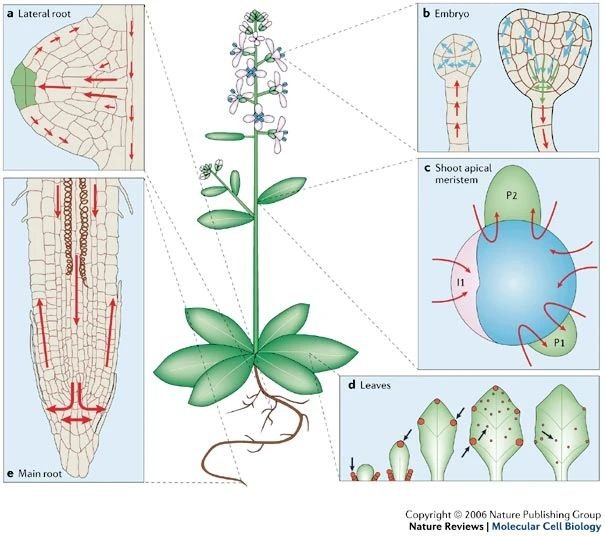Auxin transport in plants by PIN8
Auxin is a key regulator of plant growth and development. It is responsible for phototropism, which is the ability of plants to direct growth towards a light source. In addition, auxin plays crucial roles in gravitropism (roots growing in a downward direction), patterning and development. These behaviors all rely on Polar Auxin Transport (PAT), which is an ability of the plant to transport auxin across its various tissues to the site where it stimulates cell division, expansion and differentiation. For this process, the plant has specific membrane proteins that belong to the PIN family. The colored arrows on the illustration represent transport by various family members.
Auxins represent a class of small molecules
The presence of a hormone that controls plant growth has been a topic of study for 250 years. In 1880, Darwin postulated that something was transmitted to one side of the plant, causing it to bend toward the light. In the 1920’s and 1930’s, Frits Went identified indole acetic acid (IAA), which is indeed the prevalent auxin in plants and is synthesized from tryptophan. Transport of IAA by PIN transporters was established in the 1990’s. In addition to IAA, there exist a variety of other natural auxins as well as synthetic agonists and antagonists used both for experimental work and as herbicides. In particular, naphthylphthalamic acid (NPA) was identified as a potent inhibitor of growth in the 1950’s, although its specific association with PIN transporters has only recently been established.
PIN proteins responsible for auxin transport
Mutation of PIN1 in Arabadopsis perturbs formation of the central stalk and flowering (inflorescence). PIN2 controls downward grown of roots. The family includes eight different homologs with canonical (1, 2, 3, 4, 7) and non-cononical (5, 6, 8) members distinguished by the length of an intracellular loop. This loop is implicated in phospho-regulation of activity, with canonical members requiring phosphatase activity for activation in Xenopus oocyte assays. In collaboration with the laboratory of Bjørn Pedersen at Aarhus University and the laboratory of Ulrich Hammes at the Technical University of Munich, we are studying the non-canonical PIN8, which has a short intracellular loop and appears to be constitutively active.
Cryo-EM structure of PIN8
Cryo-electron microscopy was used to solve structures of PIN8, thus revealing a dimeric complex. Each protein comprised a pseudo-repeat of five transmembrane helices which assembles into a scaffold domain and a transport domain. An interrupted helix (4a & 4b) produces a cross-over motif at the interface between these two domains and lies at the center of the substrate binding pocket. The structure of the apo state represents an outward facing conformation in which the empty substrate binding site faces the outside of the cell.
PIN8 operates via an elevator mechanism
Additional cryo-EM structures were solved in the presence of the canonical auxin, IAA, as well as the inhibitor and herbicide, NPA. The latter was in an inward-facing conformation revealing domain movements associated with transport. In particular, movement of the transport domain relative to the scaffold domain not only alternates accessibility of the binding pocket, but also displaces the substrate relative to the membrane plane. Such movements have been described as an elevator mechanism and have been seen in transporters of a variety of other substrates: e.g., bile acids, and exchange of bicarbonate/sodium and sodium/protons.
Read More
K.L. Ung, L. Schulz, D.L. Stokes, U.Z. Hammes & B.P. Pedersen Substrate recognition and transport mechanism of the PIN-FORMED auxin exporters. Trends in Biochem. Sci. (2023). doi.org/10.1016/j.tibs.2023.07.006
K.L. Ung, M. Winkler, L. Schulz, M. Kolb, D.P. Janacek, E. Dedic, D.L. Stokes, U.Z. Hammes & B.P. Pedersen Structures and mechanism of the plant PIN-FORMED auxin transporter. Nature (2022). doi.org/10.1038/s41586-022-04883-y




